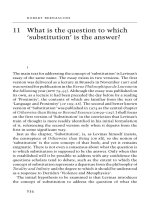The BMATT course - What is it
Bạn đang xem bản rút gọn của tài liệu. Xem và tải ngay bản đầy đủ của tài liệu tại đây (196.97 KB, 10 trang )
BMATT Course: Introductory Lesson:
The BMATT course: What is it?
Why does the British Army run the course?
Non Commissioned Officers (NCOs) in many NATO armies do things differently from
NCOs in non-NATO armies. This causes problems when these armies work together.
NATO wants the NCOs in the countries who have just joined or about to join NATO to be
like NCOs in NATO. NATO can’t train all NCOs in new NATO countries and PfP
countries. There are too many of them. What they can do is train a small number of NCOs
who will later train other NCOs. The British Army has volunteered to do this training.
People on the courses will learn how to be NATO NCOs and learn how to train NCOs in
their own army.
1. Look at the statements below and decide if they are true or false.
a) NCOs do the same things in all armies.
b) There are problems with armies working together
c) NATO wants its NCOs to be like NCOs in the countries about to join NATO
d) NATO can train all NCOs
e) NCOs on the course will later train other NCOs
f) The British Army is doing the training.
g) On the course you won’t learn how to train others.
What will you be doing on the course?
The course starts with weapons training. You will learn about the weapons you will be
using on the course. These are not the same as the weapons you use. There are two reasons
for this training. The first is safety. You have to know about the weapons you will use so
that you can’t hurt yourself or anyone else. The other reason is that it shows you the British
Army method of teaching practical skills. That method is EDIP, Explain, Demonstrate,
Imitate, Practise.
The course goes on to physical training. You will be taught how to run physical training
sessions for their soldiers and how to train senior NCOs to run these sessions.
2. What are the two reasons for weapons training?
a) …………………………………………………………………………………………
b) ………………………………………………………………………………………...
3. What does EDIP mean?
……………………………………………………………………………………………
Attention! A Military English Course for NCOs
The second phase of the course is tactical training, in which you will be taught how to train
soldiers to train others by means of preparing for three tactical exercises:
Living in the field. This includes building shelters, cooking, digging trenches etc
Teaching tactical skills. This includes patrolling, reconnaissance, attacks, planning,
receiving and giving briefings.
Battle physical training. This exercise is a practical battle training exercise that is run by
the participants with the instructors acting as observers.
4. Look at the following list of activities. On which tactical exercise will these activities
happen? Write LTF for Living in the Field, TTS for Teaching Tactical Skills and BPT for
Battle physical training.
Instructors act as observers cooking patrolling participants run courses
giving briefings digging trenches reconnaissance attacks
training for a real battle building shelters
The following phase of the course is operations training for peace support operations
(PSO). This includes discussions, study of and practising practical applications of the rules
of engagement. It also includes training and trainer training in duties that are specific to
PSO including setting up and running vehicle checkpoints and searching people for
concealed weapons.
This is followed by range instruction, in which every participant is taught how to run a
training session on a firing range using all the infantry weapons they were taught to use in
the first part of the course.
In the final week, the participants have to plan, organise and run a training programme in
which they have to evaluate the resources they have, formulate a training plan including
formulating their aims and activities and then implementing the training programme they
have put together.
5. Answer the following questions.
a) What will you discuss, study and practise? ……………………………………..
b) What two PSO activities are mentioned 1) ………………………………………
2) …………………………………….
c) Where will you use all infantry weapon? ………………………………………..
d) What will you evaluate in the final week? ……………………………………….
e) What will you formulate? ………………………………………………………..
f)
What will you implement? ……………………………………………………….
Attention! A Military English Course for NCOs
BMATT Course: Introductory Lesson: Answer Sheet.
1. Look at the statements below and decide if they are true or false.
a) NCOs do the same things in all armies. F
b) There are problems with armies working together T
c) NATO wants its NCOs to be like NCOs in the countries about to join NATO F
d) NATO can train all NCOs F
e) NCOs on the course will later train other NCOs T
f) The British Army is doing the training. T
g) On the course you won’t learn how to train others. F
2. What are the two reasons for weapons training?
a) Safety
b) To demonstrate the British Army training method
3. What does EDIP mean?
Explain, Demonstrate, Imitate. Practice
4. Look at the following list of activities. On which tactical exercise will these activities
happen? Write LTF for Living in the Field, TTS for Teaching Tactical Skills and BPT for
Battle physical training.
Instructors act as observers (BPT) cooking (LTF) patrolling (TTS)
participants run courses (BPT) giving briefings (TTS) digging trenches (LTF)
reconnaissance (TTS) attacks (TTS) training for a real battle (BPT)
building shelters (LTF)
5. Answer the following questions.
a) What will you discuss, study and practise? Practical applications of rules of
enagagement
b) What two PSO activities are mentioned 1) running vehicle checkpoints
2) searching people
c) Where will you use all infantry weapon? on a firing range
d) What will you evaluate in the final week? resources
e) What will you formulate? a training plan
f) What will you implement? a training programme
British Army Infantry Weapons. Listening Text.
Part One
You have in front of you three pictures of the basic weapons used by the British Infantry.
They are the S.A. 80 rifle, the Light Support Weapon, or LSW, and the General Purpose
Machine Gun, the GPMG.
Well, we’ll look at the S.A. 80 rifle first. Lets start at the right of the picture as you look
at it. The part that you put against your shoulder when you are firing is called the butt.
The butt.
The part at the top of the rifle, the part that you look through, is called the Optical Sight.
The Optical Sight. The optical sight makes sure you fire accurately.
Moving further along the rifle we have the Grenade launcher. This is used to fire
grenades, small bombs that are sometimes thrown and sometimes fired from a rifle. So
that is the grenade launcher.
At the end of the rifle we have the flash eliminator. The Flash eliminator. When you fire
a gun or a rifle, there is a burst of light at the end of the rifle. That flash of light can give
away your position. So, you need a flash eliminator which stops the light.
Part Two
So, that’s the SA 80 rifle, we will move on to the Light Support Weapon. The LSW.
Again, starting from the right of the picture as you look at it. The long thin bit at the end
is the Shoulder strap. The Shoulder strap.
Moving along we have the curved bit sticking out at the bottom, this is the Magazine. The
magazine contains the rounds, that is the bullets.
A little further along, and also at the bottom of the weapon is the trigger. You pull the
trigger to fire the weapon.
There are two things at the end of the rifle that are used together to let you stand the
weapon on the ground. They are the outrigger and the bipod. The outrigger supports the
weapon. The bipod is two legs on which you can stand the weapon.
Part Three
And finally we move on to the General Purpose Machine Gun. The GPMG. Again,
starting on the right as you look at it. At the end of the weapon are the sights. They let
you fire accurately.
Then we have the barrel. The barrel is the long thin tube along which the round travels.
And finally, we have the hand grip. This is the place you hold the weapon as you fire it.
British Army Infantry Weapons: Worksheet One
1. The following are the names of parts of the three main weapons used by the British
Infantry. Can you put the names on the pictures below in the places indicated by lines?
Hand Grip, Shoulder Strap, Trigger, Flash Eliminator, Barrel, Bipod, Butt,
Magazine, Optical Sights, Sights, Grenade Launcher, Outrigger
S.A. 80 Rifle
2. Now listen and check to see if you were right. Make corrections if you were wrong.
Attention! A Military English Course for NCOs









